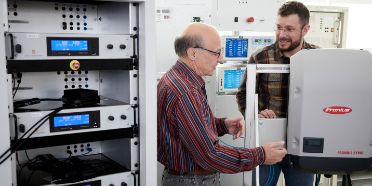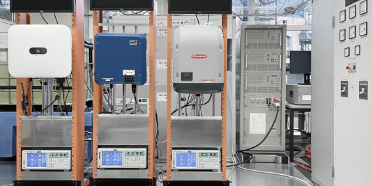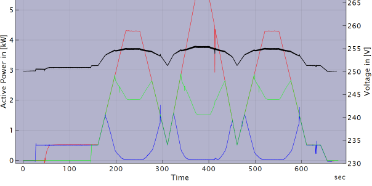GODA - grid optimisation with decentralised actors
Power curtailment of a PV system relieves the strain on the grid while resulting in barely any loss of energy yield. The inverter P(U) control function was tested in a field trial and analysed for reliability and stability in the lab.
Factsheet
- Lead school School of Engineering and Computer Science
- Institute Institute for Energy and Mobility Research IEM
- Research unit IEM / Photovoltaic systems
- Funding organisation Schweizerische Eidgenossenschaft (Bundesverwaltung)
- Duration (planned) 01.11.2021 - 01.07.2023
- Project management Prof. Dr. Christof Bucher
- Head of project David Joss
-
Project staff
Peter Wüthrich
Luciano Borgna
Marco Pascal Zaugg -
Partner
Bundesamt für Energie BFE
Groupe E SA - Keywords Active power control; grid connection of photovoltaic systems; P(U); SmartGrid; grid stability; grid integration; renewable energies; decentralised connection of energy generation systems
Situation
The majority of PV inverters available today come equipped with voltage-dependent active power control – P(U) for short – as a standard function that can be activated. However, the decentralised control method is currently still rarely used or considered, especially in grid planning, even though it offers considerable advantages over grid reinforcement or static active power curtailment. This is why Groupe E SA wants to configure decentralised photovoltaic inverters to enable them to reduce their output independently and in a controlled way when grid voltage is too high. This is monitored and solar power producers compensated based on smart-meter data. If the project proves successful, future investment in grid reinforcement for decentralised energy-generation plants could be optimised and potentially postponed for years.
Course of action
In the GODA project, Groupe E SA tested the use of P(U) in the distribution grid on selected PV systems in a field trial. For this purpose, the inverters were parameterised in two periods with different characteristic curves for the voltage-dependent active power control. By applying machine learning to the energy production, it was possible to estimate the feed-in that was avoided. At the BFH Photovoltaic Systems Laboratory, measurements were carried out on inverters to ascertain the reliability and stability of the P(U) control. This involved testing the limits of the systems by varying certain relevant parameters such as the steepness of the P(U) curve or time constants for setpoint filters. Of particular interest was the question as to whether individual inverters behave differently than a group of inverters at the same connection point.
Result
The project successfully adjusted the voltage-dependent active power control P(U) and tested it on PV systems in the field. The inverters demonstrated the desired reduction in active output when the grid voltage was too high. Using self-learning algorithms that evaluated the smart meters' production data, it was possible to calculate the production losses and compensate the system operators. With typical settings for the control parameters, the measurements in the lab demonstrated stable inverter behaviour – both individually and in groups. However, the researchers observed major differences in the control behaviour of the individual units, which is primarily due to the measurement tolerances of the internal voltage measurement. In some measurement situations, significant temporary power fluctuations and minor reciprocal interference between the inverters were observed. The GODA project is thus able to demonstrate that the voltage-dependent active power control P(U) generally functions reliably and stably with appropriate inverter settings.
Looking ahead
Groupe E SA is continuing to assess the use of P(U) as a grid support measure in a pilot phase in the field trial area. The approach they take is to make maximum use of the voltage band and to activate the power curtailment of the flexible PV systems when coming close to the upper limit for the grid voltage at 110%. In future, the BFH Laboratory for Photovoltaic Systems will work on suitable test patterns for P(U) in the context of standards development (IEC 63409 series). The aim here is to specify targets for the implementation of P(U) that are as binding as possible, that are internationally accepted and that give the distribution grid operators clarity about the reliability and accuracy of the control variables, so that voltage-dependent active power control can establish itself as a reliable measure for voltage stability.



